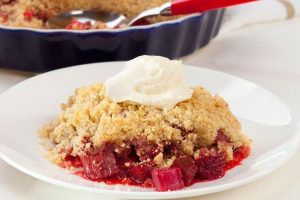Botanical name: Rheum rhabarbarum
Potential height: up to 1 metre
Best eaten in: an apple and rhubarb crumble with lots of custard!
So, if you haven’t guessed already, I’m a bit of a fan of rhubarb (well desserts in general) but rhubarb crumble is one of my favourites. And with spring and warm days approaching it’s the perfect chance to get one in for your own crumble or whatever recipe you enjoy it in too.
While it may be easy to eat it isn’t always easy to grow. So I’d thought I’d use the opportunity to run through a few tips for success:
Prep– Plant rhubarb from June to September either on the edge of your vegie patch or in a separate garden bed or container where it can happily live undisturbed. I find afternoon shade is best when summer comes along. Full blazing sun on a 40-degree day can set them back and tends to make them shabby.
Where to grow– Rhubarb can be grown in the ground or in a container but for best results plant 90 centimetres apart.
Feed– Feed your rhubarb with a liquid nitrogen fertiliser every four to five weeks from early spring through to autumn to maximise your yield. It’s not a ‘must-do’ but if you harvest a lot regularly then it’s definitely beneficial.
Water-Rhubarb will grow best with regular watering, but good drainage is important as it hates wet feet. Water deeply during hot periods to encourage stem growth.
Protect– Rhubarb is a relatively hardy edible to grow but can be affected by aphids, whitefly and caterpillars. Check foliage regularly and squash or squirt off aphids with a sharp jet of water and remove caterpillars. If needed, try using an organic insecticide such as pyrethrum according to instructions which is safe to use of edibles and controls aphids and whitefly.
Harvest– Harvest during spring and summer and pick from the outside stems first. Remove stems cleanly with a quick downwards and sideways action. To keep the plant producing stems always leave the younger stems in the centre of the plant. If any flowering stems appear cut off at the base and feed with a liquid nitrogen fertiliser to encourage more foliage and stem growth.
And finally, a note of caution- Toxicity– The large leaves are beautiful but shouldn’t be included on the menu as they contain high concentrations of oxalic acid which is poisonous.

We’ve got some lovely crimson stemmed stock in now which seems to be taking advantage of the beautiful weather and are powering away. Best get in quick if you’re looking for one though- I just bought a bigger crumble tin!
Happy gardening,
Caitlin
Wingham Nursery & Florist
winghamnurseryandflorist.com.au
